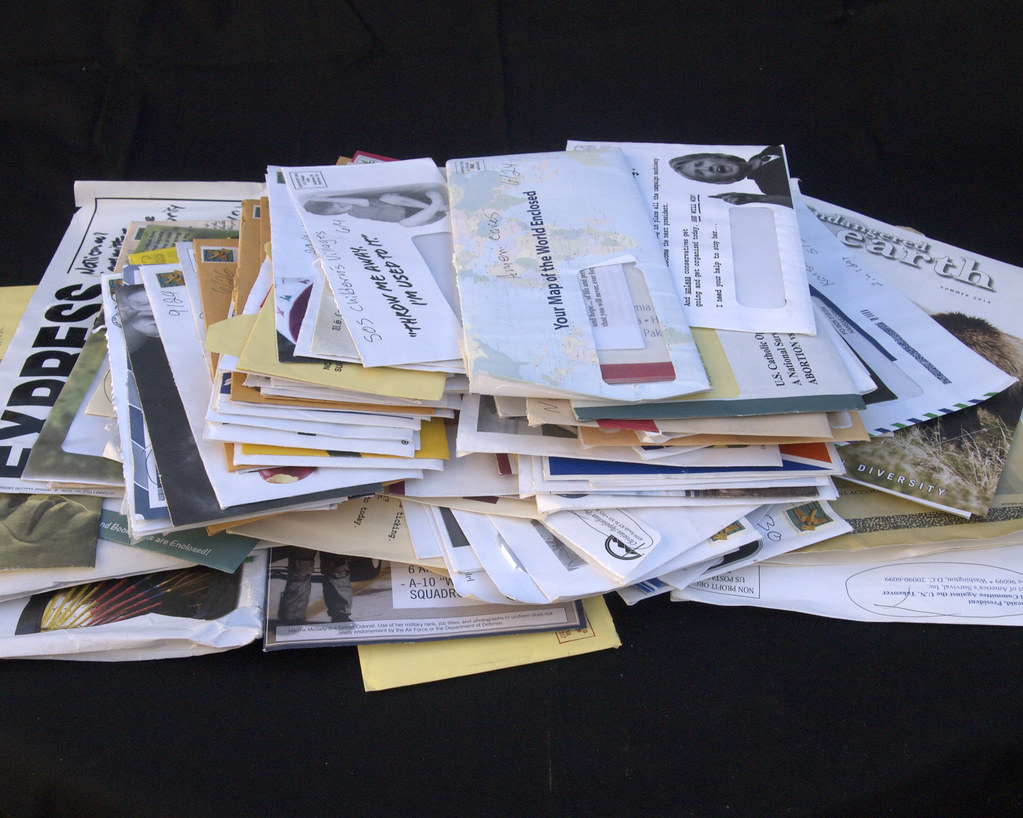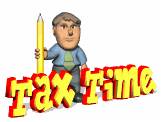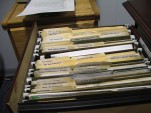
While we’ve been sheltering-in-place and social-distancing, I’ve been thinking about all the traveling I’ve done. Whether it’s a quick overnight or weekend trip or something longer, like 2 – 3 weeks, I’ve been remembering my wallet and how it gets filled with all sorts of paper not related to anything I needed to carry with me.
My wallet has been filled with receipts, ticket stubs, candy wrappers, etc. Were all these extraneous things necessary to stuff into my wallet? For me, this was the best place to keep all these items temporarily until I got home, when I could empty my wallet, file what I needed to keep in their respective “homes”, and discard the rest (I sure didn’t need to keep a candy wrapper). Do many of you have things like this in your wallet all the time?
How much you can fit in your wallet is really a metaphor for how much you can fit in your surroundings. Are you ready to “Empty Your Wallet” (and I don’t mean emptying it of money)? I’m talking about your wallet representing how light you would feel if you emptied your life of all the extraneous things that don’t need to be kept in it. What is actually important to you? What do you really need, not want, to keep in your life to make it seem less weighty? The 4 benefits of having an “empty wallet” are:
“Do not wait: the time will never be ‘just right’. Start where you stand, and work whatever tools you may have at your command and better tools will be found as you go along.” Napoleon Hill
Now is Your Time to “Empty Your Wallet”

Everyone hates to file papers and we all have piles of them on our desks, tables, and any other flat surface around. No one likes to deal with all the papers that we still have even in our modern “paperless” society. Today I offer an easy, simple system that is not overwhelming and will have you binging Netflix in no time. The best part of this solution is that it’s only two steps!!
Even as a professional organizer, my ADHD gets in the way of keeping my attention on sorting papers for any significant length of time. As everyone knows, dealing with papers is boring. It becomes overwhelming so we give up and give in to the piles. So, out of necessity, I created this quick and easy system for dealing with the paper piles.

Step 1: Get 2 containers – boxes, plastic bins, baskets etc. to hold your papers. They can be pretty or they can be from the liquor store. The look of the container is up to you.
Step 2: Answer one yes or no question for each paper: “Does this paper have anything to do with my money, property, legal identification, or taxes?” If the answer is yes, it goes in box #1. If the answer if no, then it goes into box #2.
That’s it, you’re done filing! Even if you never do anything else with either box, you will be able to find any important paper that you need, when you need it. Most papers that we think we need to keep are rarely, if ever, referenced again.
If you need to find an important legal document, receipt or tax info you only have to look in Box #1. You don’t need to be distracted by all the non-legal or non-financial papers to find what you need. Your stress level is greatly reduced or even eliminated. If there is ever an emergency, storm, fire, or other need to evacuate quickly, you just have to grab Box #1.
Now, a lot of people would just not feel completely comfortable with this simple system. If you fall into this category, then take the next step. Get a 3-ring binder and some sheet protectors. Place all of the most critical documents – your birth certificates, passports, Social Security cards, marriage and divorce documents, property deeds, college transcripts, etc. and put them into the page protectors in the binder. Keep this binder in or near Box #1 and let all household members know about it and where it is. Believe me, this will save you so much time and stress when you need to locate these documents.
I know that this system works well as I just completed the process of getting both my Real ID and my passport. It was so much easier knowing where all of the documents were and that they were all together.

Now that you paper piles are tackled, grab some ice cream and enjoy your favorite show or activity. Guilt free. Now you are organized…at least with your papers!

First, let me confess: I am NOT what you might call an “Early Adopter” when it comes to technology.
I need to know that an app/program has been around a long time, is secure and is fast and easy to learn and use.
Here are 5 tech tools that meet those requirements. Use them daily to free up mental clutter, to run on time with appointments and projects, and to help you access information quickly.
You will enjoy the benefits of a calmer daily routine and the ability to access information speedily if you take a little effort to use one or more of these tech tools!
My Evernote conversion occurred about five years ago. Stuffed in the back of my junk drawer (yes, I also have one) for several years, lay a handwritten recipe for the best maple balsamic salad dressing obtained from a restaurant in Vermont. Frustrated with my lack of organization for something so valuable, I downloaded Evernote and my life was forever changed.
I created a notebook in the Evernote app and titled it “Recipes,” took a photo of the recipe within the Evernote app et voila! Wherever I am, on my phone, tablet or laptop I have a screenshot of the recipe. I quickly saw how transformational this would be in both my personal and professional life. When a friend recommends a great restaurant, it goes into the notebook I created titled “Recommended Restaurants”. I also do this for movies, books, wine, travel destinations, decorating ideas. All those great details we scribble on the back of napkins never to find again.
If I’m surfing the web, I can use Evernote webclipper to clip an article or page and put it into the notebook of my choice. I can also dictate notes into Evernote and draw using the Skitch app.
I also have a notebook for each of my kids. I have a screenshot of their health insurance cards, health records, photos of their artwork from Kindergarten so I could get rid of those large poster-size monstrosities, er, I mean works of art. The list goes on.
For my business, I’m able to share notebooks with my team and with our clients. We often take notes during an organizing session and share these with our clients. Evernote also eliminates the need to email documents back and forth. Instead, the whole team can collaborate and has access whether they are working remotely or in the office to notes, documents, photos, etc.
I’m barely scratching the surface of Evernote’s endless possibilities. For more information and to create your free online account check out www.evernote.com

One of the most confusing parts of getting ready for tax time is knowing what documents you need to prepare your taxes. Basically, the documents break down into three categories: Income statements, deductions, and receipts.
The Challenge of Receipts
Receipts are the most challenging documents to store and organize. This is especially true if you are a small business owner. Receipts are your main protection if the IRS decides to audit and details are critical. It’s imperative to keep all receipts pertaining to business and a very good idea to get into the habit of making notes on entertainment and dining expense receipts.
Consider Scanning for Added Protection
Scanning your receipts can help solve two problems. First, if the IRS comes knocking, they won’t care that your receipts from four years ago have faded; so scanning receipts is a great way to give you that added layer of protection. Secondly, if you set up a system to scan as you go, then you won’t have to wonder where all your receipts are stored, and you won’t have to deal with that shoebox full of papers come tax time. There are many smartphone apps dedicated to receipt scanning that are easy to use and can save you hours of searching, sorting, and organizing papers during tax time.
Income Statements:
W-2 – wages and salary
W-2G – gambling winnings
Form 1099-R – retirement income
Form 1099-INT – interest
Form 1099-DIV – dividends
Form 1099-MISC – miscellaneous income, including self-employment
Form 1099-G – government payments
Form 1099-SA – MSA or HSA distributions
Form 1099-B – broker or barter exchanges
Form SSA-1099 – Social Security benefits
Form RRB-1099 – railroad retirement
Schedule K-1 – partnership income or loss
Deductions:
Form 1098 – mortgage interest
Form 1098-T – tuition
Form 1098-E – student loan interest
Receipts & Records:
Unreimbursed mileage related to work or volunteering
Charitable donations
Contributions to retirement plans
Healthcare expenses
Self-employment income and expenses, including any:
-Home-office expenses
-Health-insurance premiums paid
-Transportation costs
-Advertising fees
Rental property
Moving expenses, if you moved for a new job
Expenses for energy-efficient home improvements
Tuition or fees paid for education for you, spouse, or dependents
Retirement account rollovers
Child care and dependent care expenses, including the employer identification number (EIN) or SSN of the care provider
Additional Documents:
Your Social Security number (SSN) or taxpayer identification number (ITIN) and SSN’s or ITIN’s for spouse and dependents (if any)
Your birth date and birth date for spouse and dependents (if any)
A copy of last year’s return
Documents List Source: H&R Block
I look at the last week of the year as a super productive week since I am not scheduled to work, and I can spend time getting myself ready for the new year. I want to be as organized as possible before January 5, 2015, which is my first day back to work! Below is a list of suggestions that may help you start your new year off a bit more organized.
Donations 
-If you want to maximize your donations for the 2014 tax year, take one more look through your closets, bookshelves, cabinets, attics, basements and garages to pull anything out that needs to be donated. Children’s toys and books are usually a gold mine for most donation establishments.
-After the holidays, as you integrate your new gifts, take stock of your duplicates, triplicates or otherwise unwanted things that can be better utilized by others.
-Keep in mind that you shouldn’t wait until December 31 to drop off your donations, because if the center hits their capacity level, they may stop accepting donations.
-Some donation centers will pick up your unwanted goods as long as you are on their schedule. Some donation center choices are GreenDrop, Vietnam Veterans of America, The Salvation Army, and Impact Thrift Stores.
-Make your final online cash donations as soon as possible since you don’t want to get stuck with slow or crashing websites at the last minute.
Files 
-Assuming that you have them, the end of the year is a great time to purge your old files and create new ones. If you need help creating a filing system, a professional organizer can help. You can go to the ‘Find an Organizer’ tab at the top of this page.
-Go through your 2014 bills, pull them out of their files, and clip or band them together if you are going to need them for your taxes. If you don’t need them for your taxes, I would suggest shredding anything that has personal information or account numbers. Most of my clients shred their department store bills and hold onto some of their utility bills for another year (I think they just want the security of having them…just in case).
– A filing cabinet or file box are both great choices to keep your files organized and accessible.
-If you scan your bills and receipts, remember to create new files on your computer.
Hopefully, there is something here that will help you start 2015 off with a little more organization in your world.